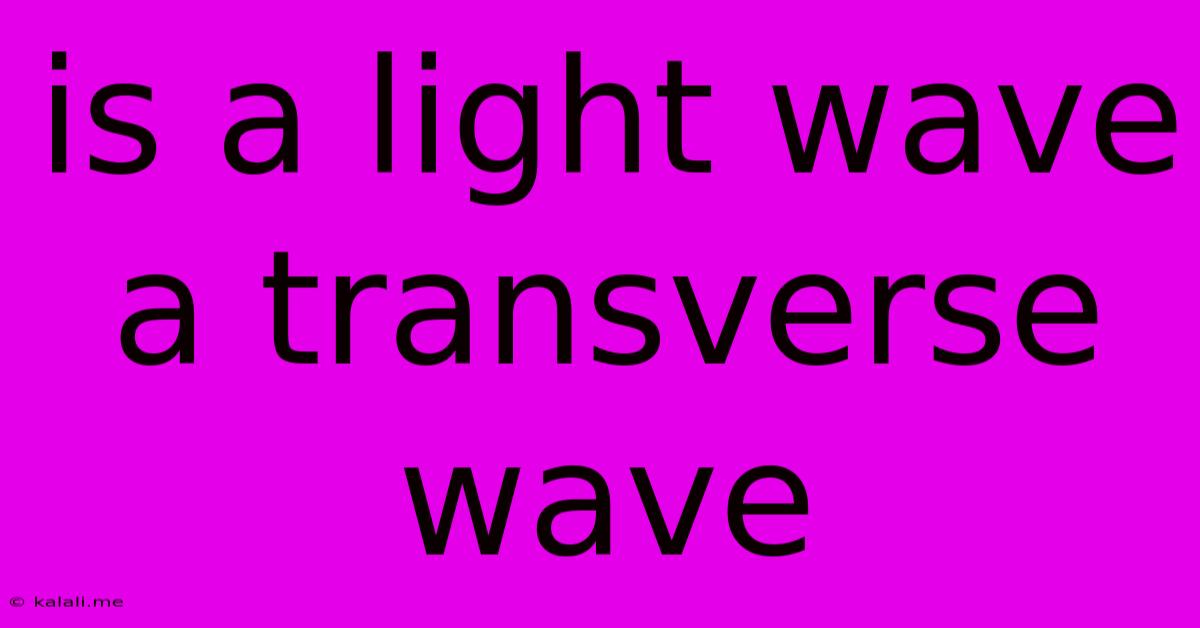Is A Light Wave A Transverse Wave
Kalali
May 21, 2025 · 3 min read

Table of Contents
Is a Light Wave a Transverse Wave? A Deep Dive into Electromagnetic Radiation
Light, the very essence of vision and a fundamental component of our universe, exhibits fascinating wave-like properties. But what kind of wave is it? This article delves into the nature of light waves, exploring their transverse nature and clarifying some common misconceptions. Understanding this is key to grasping concepts in optics, electromagnetism, and even quantum physics.
Light waves are indeed transverse waves. This means the oscillations or vibrations of the wave are perpendicular to the direction the wave travels. Unlike longitudinal waves, such as sound waves, where the oscillations occur parallel to the direction of travel, light waves have their electric and magnetic fields oscillating perpendicular to their propagation.
Understanding Transverse Waves
To fully appreciate the transverse nature of light, let's briefly define transverse waves. In a transverse wave, the disturbance that propagates through the medium (or space, in the case of light) is perpendicular to the direction of energy transfer. Imagine shaking a rope up and down; the wave travels along the rope's length, but the rope itself moves perpendicular to this direction. This is analogous to the behavior of light waves.
The Electromagnetic Nature of Light
Light isn't a mechanical wave needing a medium to propagate; it's an electromagnetic wave. This means it's comprised of oscillating electric and magnetic fields. These fields are mutually perpendicular to each other and to the direction of wave propagation. This self-sustaining oscillation of electric and magnetic fields is what constitutes a light wave. The speed of light in a vacuum, approximately 3 x 10<sup>8</sup> m/s, is determined by the properties of these fields.
Evidence for Light's Transverse Nature
Several phenomena support the classification of light as a transverse wave:
-
Polarization: This is perhaps the most compelling evidence. Polarization refers to the restriction of the electric field oscillations to a specific plane. This is only possible with transverse waves. Polarizing filters, for example, only allow light waves with electric fields oscillating in a particular direction to pass through, effectively filtering out others.
-
Diffraction and Interference: While both longitudinal and transverse waves exhibit diffraction and interference, the specific patterns observed in light experiments are consistent with a transverse wave model.
-
Electromagnetic Spectrum: The wide range of electromagnetic radiation, from radio waves to gamma rays, all share this transverse wave characteristic, further solidifying this understanding.
Common Misconceptions
Some might mistakenly associate the direction of photon movement with the oscillation direction, leading to confusion about the transverse nature. It's crucial to remember that the oscillation refers to the electric and magnetic fields, not the photons themselves. Photons, the fundamental particles of light, travel in the direction of wave propagation.
Conclusion
In conclusion, light waves are definitively transverse electromagnetic waves. Their electric and magnetic fields oscillate perpendicularly to their direction of travel, a property demonstrably supported by phenomena like polarization. Understanding this fundamental aspect of light is crucial for a deeper comprehension of optics, electromagnetism, and the wave-particle duality of light. This knowledge serves as a foundational building block for exploring more advanced concepts in physics.
Latest Posts
Latest Posts
-
How Do You Get Dried Blood Out Of Carpet
May 21, 2025
-
Water Heater Pressure Relief Valve Dripping
May 21, 2025
-
How Does Voldemort Hold His Wand
May 21, 2025
-
How Long Will A Thermos Keep Water Hot
May 21, 2025
-
What Is The Opposite Of Yellow
May 21, 2025
Related Post
Thank you for visiting our website which covers about Is A Light Wave A Transverse Wave . We hope the information provided has been useful to you. Feel free to contact us if you have any questions or need further assistance. See you next time and don't miss to bookmark.